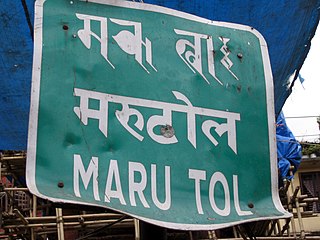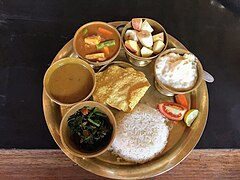Gorkha Kingdom was a kingdom in the confederation of 24 states, known as Chaubisi rajya, located in the Indian subcontinent, present-day western Nepal. The Kingdom of Gorkha extended from the Marshyangdi River in the west to the Trishuli River in the east, which separated it from the kingdoms of Lamjung and Nepal respectively. The Gorkha Kingdom was established by Prince Dravya Shah, second son of King Yasho Brahma Shah of Lamjung Kingdom, on 1559 CE replacing the Khandka chiefs.

Newar or Newari, also known as Nepal Bhasa, is a Sino-Tibetan language spoken by the Newar people, the indigenous inhabitants of Nepal Mandala, which consists of the Kathmandu Valley and surrounding regions in Nepal.

Newar, or Nepami, are the historical inhabitants of the Kathmandu Valley and its surrounding areas in Nepal and the creators of its historic heritage and civilisation. Newars form a linguistic and cultural community of primarily Indo-Aryan and Tibeto-Burman ethnicities following Hinduism and Buddhism with Nepal Bhasa as their common language. Newars have developed a division of labour and a sophisticated urban civilisation not seen elsewhere in the Himalayan foothills. Newars have continued their age-old traditions and practices and pride themselves as the true custodians of the religion, culture and civilisation of Nepal.

The Rañjanā script (Lantsa) is an abugida writing system which developed in the 11th century in Nepal and until the mid-20th century was used in an area from Nepal to Tibet by the Newar people, the historic inhabitants of the Kathmandu Valley, to write Sanskrit, Tibetan, and Newari. Many of the most famous Buddhist and Hindu texts produced in the region were written in Ranjana, which became one of the iconic scripts of Nepal. Nowadays it is also used in Buddhist monasteries in India, China, especially in the Tibetan Buddhist areas within the Tibet Autonomous Region, Sichuan, Yunnan, Qinghai and Gansu, Mongolia, and Japan. It is normally written from left to right but the Kutakshar form is written from top to bottom. It is also considered to be the standard Nepali calligraphic script.

The Kathmandu Valley, historically known as Nepal Valley or Nepa Valley, lies at the crossroads of ancient civilizations of the Indian subcontinent and the broader Asian continent, and has at least 130 important monuments, including several pilgrimage sites for Hindus and Buddhists. There are seven World Heritage Sites within the valley.

Dolakha, often known as Dolkha or Dholkha, a part of Province No. 3, is one of the seventy-seven districts of Nepal. The district, with Charikot as its district headquarters, covers an area of 2,191 km² and has a population of 204,229 in 2001 and 186,557 in 2011. It is a district with a strong religious affiliation. It is popularly known amongst most Nepalese for the temple of Dolakha Bhimeshawor.city
Guthi is a social organization that is used to maintain the socio-economic order of Nepalese society The guṭhī system has been in operation since the Licchavi era, with the first practice being recorded in scriptures on pillars erected at Changu Narayan temple, which in itself is regarded to be the oldest dated inscription of Nepal. Currently, most of the guṭhīs are either defunct or a vestigial representation of what used to be the most powerful organized community of the Newars. However, some of these guṭhīs still exist with its own purpose, and their functions governed by the internal unwritten rules; often kept secret and revealed only to its members. During the course of time, the male family members of pre-existing members are handed out the responsibilities associated with the guṭhī. The "Guthi Bill", tabled in the Upper House of the Federal Parliament of Nepal on April 2019, was highly controversial and prompted a number of mass protests against the bill, especially in the Kathmandu Valley.

Nepali/Nepalese cuisine comprises a variety of cuisines based upon ethnicity, soil and climate relating to Nepal's cultural diversity and geography.

The expression Nepalese Scripts refers to alphabetic writing systems employed historically in Nepala Mandala by the indigenous Newars for primarily writing Nepalbhasa and for transcribing Sanskrit. There are also some claims they have also been used to write the Parbatiya (Khas) language but all Pahari languages were traditionally written with the Takri alphabet and now Devanagari.

Bhimeshwar,, is a municipality in north-eastern Nepal and the headquarters of Dolakha District in Province No. 3 that was established in 1997 by merging the former Village development committees Charikot, Dolakha Town, Makaibari and Mati. At the time of the 2011 Nepal census it had a population of 32,486 people living in 8,639 individual households. The town is located at an altitude of 1554 metres (5101 feet). The name of the district Dolakha came from Dolakha Town situated north-east of the headquarters Charikot Bazaar.

Newa art is the art form practiced over centuries by Newa people. The pictorial art consists of:
The community of Nepalis in China consists of Nepalese immigrants and expatriates to China as well as Chinese citizens of Nepalese descent.
Thangmi, also called Thāmī, Thangmi Kham, Thangmi Wakhe, and Thani, is a Sino-Tibetan language spoken in central-eastern Nepal and northeastern India by the Thami people. The Thami refer to their language as Thangmi Kham or Thangmi Wakhe while the rest of Nepal refers to it as Thāmī. The majority of these speakers, however, live in Nepal in their traditional homeland of Dolakhā District. In India, the Thami population is concentrated mostly in Darjeeling. The Thangmi language is written using the Devanagari script. Thangmi has been extensively documented by Mark Turin.

Sthāpit is a Nepalese caste from the Newa people of the Kathmandu Valley in Nepal. Sthapits are part of the Uray group which includes Tuladhar, Kansakar, Tamrakar, Bania, Sindurakar, Selalik Kasthakar and other castes. Their religion is Newar Buddhism and their mother tongue is Nepal Bhasa.

Nepali is an Indo-Aryan language of the sub-branch of Eastern Pahari. It is the official language of Nepal and one of the 22 scheduled languages of India. Also known by the endonym Khas Kura, the language is also called Gorkhali or Parbatiya in some contexts, It is spoken mainly in Nepal and by about a quarter of the population in Bhutan. In India, Nepali has official status in the state of Sikkim, and significant number of speakers in the states of Arunachal Pradesh, Himachal Pradesh, Manipur, Mizoram, Uttarakhand and West Bengal's Darjeeling district. It is also spoken in Burma and by the Nepali diaspora worldwide. Nepali developed in proximity to a number of Indo-Aryan languages, most notably the other Pahari languages and Maithili, and shows Sanskrit influence. However, owing to Nepal's location, it has also been influenced by Tibeto-Burman languages. Nepali is mainly differentiated from Central Pahari, both in grammar and vocabulary, by Tibeto-Burman idioms owing to close contact with this language group.

Province No. 3 is one of the seven provinces of Nepal established by the country's new constitution of 20 September 2015. Home to the country's capital Kathmandu, it is mostly hilly and mountainous, home to peaks including Gaurishankar, Langtang, Jugal, and Ganesh. The province covers an area of 20,300 km2, about 14% of the country's total area, and has an altitude low enough to support deciduous, coniferous, and alpine forest and woodland. Temperature varies with altitude. Rainfall takes place mainly during the summer.

Karnali Pradesh is one of the seven federal provinces of Nepal formed by the new constitution which was adopted on 20 September 2015. The total area of the province is 24,453 square kilometres (9,441 sq mi), making it the largest province in Nepal. According to the 2011 Nepal census, the population of the province was 1,570,418, making it the least populous province in Nepal. It borders the Tibet Autonomous Region of China to the north, Gandaki Pradesh to the east, Sudurpashchim Pradesh to the west, and Province No. 5 to the south. Birendranagar with a population of 100,458 is both the province's capital and largest city.

The Vidhyeshvari Vajra Yogini Temple - also known as the Bijeśvarī Vajrayoginī, Bidjeshwori Bajra Jogini, Bijayaswar, Bidjeswori, or Visyasvari Temple - is a Newar Buddhist temple in the Kathmandu valley dedicated to the Vajrayāna Buddhist deity Vajrayoginī in her form as Akash Yogini. The temple stands on the west bank of the Bishnumati river next to the ancient religious site of the Ramadoli (Karnadip) cremation ground and is on the main path from Swayambhunath stupa to Kathmandu.
Devi Khadka is a Nepalese Communist politician from Dolakha, currently serving in the House of Representatives.

















